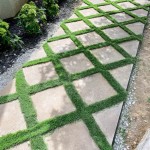How to Create a Concrete Patio: A Comprehensive Guide
A concrete patio offers a durable, versatile, and cost-effective outdoor living space. Constructing one, while demanding, is attainable with careful planning, preparation, and execution. This article details the process of creating a concrete patio, outlining the necessary steps from initial design to final finishing.
Planning and Preparation: Setting the Foundation for Success
Prior to embarking on the physical construction, thorough planning is crucial. This phase involves determining the size and shape of the patio, ensuring proper drainage, obtaining necessary permits, and procuring the required materials and tools.
The first step is to define the location and dimensions of the patio. Consider the intended use of the space, the surrounding landscape, and any existing structures. Mark the perimeter of the patio using stakes and string. Measure the area encompassed within the string to calculate the required amount of concrete. It is advisable to add a slight overage (approximately 5-10%) to account for waste and ensure sufficient material.
Drainage is paramount to the longevity of a concrete patio. Poor drainage can lead to water pooling, which can cause cracking and deterioration over time. Ensure that the patio slopes gently away from the house, typically at a rate of 1/4 inch per foot. This slope will facilitate water runoff and prevent it from accumulating on the surface.
Before commencing any construction, it is essential to check with the local municipality regarding building codes and permit requirements. Many jurisdictions require permits for concrete patios, especially if they exceed a certain size or are located within a specified distance of property lines. Failure to obtain the necessary permits can result in fines or the requirement to remove the structure.
Gathering the necessary materials and tools is a critical step in preparation. The required materials typically include: concrete mix (either pre-mixed bags or individual components), gravel base, forms (lumber or pre-fabricated forms), reinforcement materials (wire mesh or rebar), expansion joint material, and concrete sealant. Essential tools include: shovel, wheelbarrow or concrete mixer, tamper, level, screed board, bull float, edger, groover, trowel, measuring tape, safety glasses, and work gloves.
Excavation and Formwork: Building the Framework
Once the planning phase is complete, the physical construction can begin with excavation and formwork. This stage involves removing the topsoil, establishing a solid base, and creating the molds that will contain the concrete.
Begin by removing the topsoil and any organic matter within the staked area. Excavate to a depth that allows for a gravel base of at least 4 inches, plus the desired thickness of the concrete slab (typically 4 inches). The total excavation depth should therefore be a minimum of 8 inches. Use a shovel to remove the soil, and a wheelbarrow to transport it away from the construction site.
After excavation, compact the soil using a hand tamper or a plate compactor. This compaction will create a stable base for the gravel layer. Ensure that the soil is level and well-compacted before proceeding to the next step.
Next, add a layer of gravel base to the excavated area. This gravel layer serves several purposes: it provides drainage, distributes the weight of the concrete, and helps to prevent cracking. Spread the gravel evenly over the compacted soil, ensuring a minimum thickness of 4 inches. Use a rake to distribute the gravel, and then compact it thoroughly using a hand tamper or a plate compactor. Ensure that the gravel base is level and well-compacted.
Construct the forms that will contain the concrete. These forms define the shape and size of the patio. Use lumber (typically 2x4s or 2x6s) or pre-fabricated forms. Secure the forms with stakes, ensuring that they are level and plumb. The tops of the forms should be at the desired finished height of the patio. Double-check that the forms are securely fastened and will not bow or shift under the weight of the concrete.
Install expansion joint material along any existing structures, such as the house foundation or sidewalks. Expansion joints allow for movement of the concrete due to temperature fluctuations and prevent cracking. Cut the expansion joint material to fit snugly against the existing structures and secure it in place with adhesive or nails.
Pouring and Finishing: Transforming the Vision into Reality
The pouring and finishing stage is where the concrete patio takes shape. This involves mixing and pouring the concrete, leveling it, and creating the desired surface texture.
Mix the concrete according to the manufacturer's instructions. If using pre-mixed bags, add water gradually until the concrete reaches the desired consistency. If mixing from individual components, use the correct proportions of cement, sand, and gravel. A concrete mixer is highly recommended for larger patios to ensure a consistent mix.
Pour the concrete into the forms, starting at one end and working your way to the other. Use a shovel to distribute the concrete evenly within the forms. Avoid pouring large amounts of concrete in one spot, as this can create uneven settling and lead to cracking. Fill the forms to the top, ensuring that the concrete is level with the tops of the forms.
Consolidate the concrete by using a shovel or a concrete vibrator. This process removes air pockets and ensures that the concrete is fully compacted. Pay particular attention to the edges of the forms and around any embedded objects, such as reinforcement materials.
Level the concrete using a screed board. A screed board is a long, straight piece of lumber that is used to level the concrete surface. Rest the screed board on the forms and pull it across the surface, removing excess concrete and filling in any low spots. Overlap each pass slightly to ensure a smooth, level surface.
After screeding, use a bull float to smooth the surface of the concrete and remove any imperfections. A bull float is a large, flat tool that is attached to a long handle. Push the bull float across the surface of the concrete in overlapping passes, smoothing out any ridges or bumps. Do not overwork the concrete, as this can cause it to become weak and brittle.
Once the concrete has begun to set (typically after a few hours, depending on the weather), use an edger to round the edges of the patio. This will prevent the edges from chipping or cracking. Run the edger along the inside of the forms, creating a smooth, rounded edge.
Use a groover to create control joints in the concrete. Control joints are shallow grooves that are cut into the concrete to control cracking. These joints create weak points in the concrete, allowing it to crack in a controlled manner. Space the control joints approximately every 8 to 10 feet. Use a straightedge to guide the groover, ensuring that the joints are straight and evenly spaced.
Finish the concrete surface with a trowel. A trowel is a flat, rectangular tool that is used to create a smooth, dense surface. Hold the trowel at a low angle and draw it across the surface of the concrete in overlapping passes. The amount of troweling will determine the final texture of the concrete. A heavily troweled surface will be smooth and glossy, while a lightly troweled surface will be more textured.
Consider adding a decorative finish to the concrete. This can be achieved by stamping the concrete with a patterned stamp, adding color with a concrete stain or dye, or exposing the aggregate by removing the surface layer of cement paste. Choose a finish that complements the surrounding landscape and architecture.
Curing is a critical step in the concrete patio construction process. Curing involves keeping the concrete moist for several days to allow it to fully hydrate and gain strength. This can be achieved by covering the concrete with plastic sheeting, spraying it with water, or applying a curing compound. Follow the manufacturer's instructions for the curing method you choose.
After the concrete has cured for at least 7 days, remove the forms. Use a pry bar or a hammer to gently detach the forms from the concrete. Be careful not to damage the concrete in the process.
Apply a concrete sealant to protect the patio from the elements. A concrete sealant will help to prevent water from penetrating the concrete and causing damage. Choose a sealant that is specifically designed for concrete patios and follow the manufacturer's instructions for application. Reapply the sealant every few years to maintain its effectiveness.

Diy Concrete Patio In 8 Easy Steps How To Pour A Cement Slab

Concrete Patio Ideas Design Your Backyard Network

How To Pour A Concrete Patio Quick

How To Make A Concrete Patio Bigger

How To Pour A Concrete Slab Diy Family Handyman

Concrete Patio Design Ideas And Cost Landscaping Network

Poured Concrete Pavers Create A Stylish Patio The Home Depot

How To Create Faux Tile Look On Concrete Patio Makeover Paint Diy

How To Create A Diy Patio And Walkway With Quikrete Walkmaker Today S Homeowner Concrete

How To Build A Patio In Weekend Finegardening








